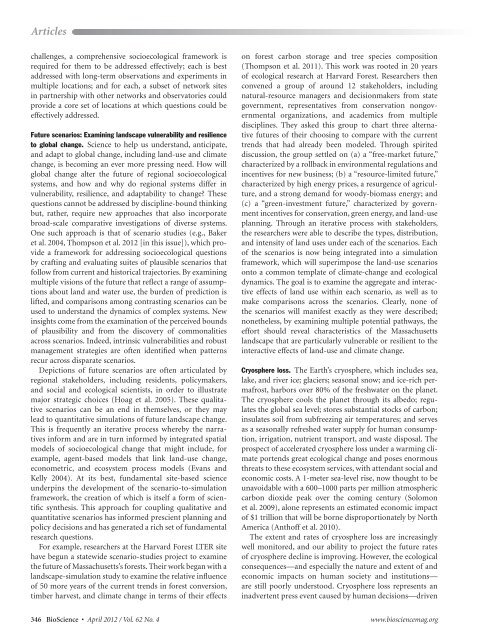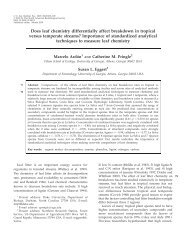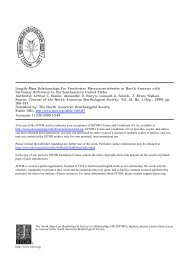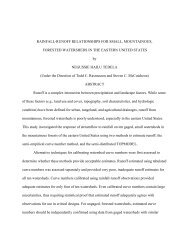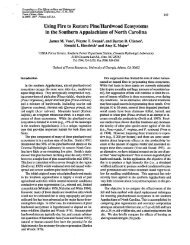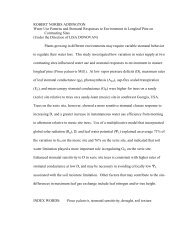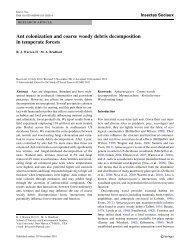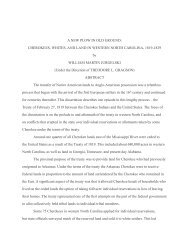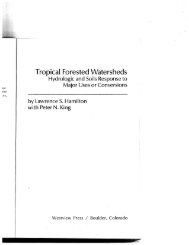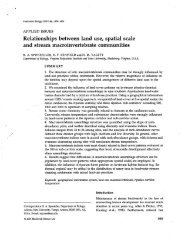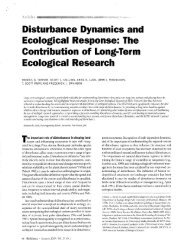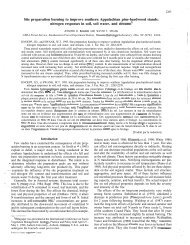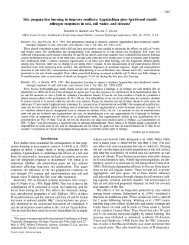biology join - Coweeta LTER - University of Georgia
biology join - Coweeta LTER - University of Georgia
biology join - Coweeta LTER - University of Georgia
Create successful ePaper yourself
Turn your PDF publications into a flip-book with our unique Google optimized e-Paper software.
Articles<br />
challenges, a comprehensive socioecological framework is<br />
required for them to be addressed effectively; each is best<br />
addressed with long-term observations and experiments in<br />
multiple locations; and for each, a subset <strong>of</strong> network sites<br />
in partnership with other networks and observatories could<br />
provide a core set <strong>of</strong> locations at which questions could be<br />
effectively addressed.<br />
Future scenarios: Examining landscape vulnerability and resilience<br />
to global change. Science to help us understand, anticipate,<br />
and adapt to global change, including land-use and climate<br />
change, is becoming an ever more pressing need. How will<br />
global change alter the future <strong>of</strong> regional socioecological<br />
systems, and how and why do regional systems differ in<br />
vulnerability, resilience, and adaptability to change? These<br />
questions cannot be addressed by discipline-bound thinking<br />
but, rather, require new approaches that also incorporate<br />
broad-scale comparative investigations <strong>of</strong> diverse systems.<br />
One such approach is that <strong>of</strong> scenario studies (e.g., Baker<br />
et al. 2004, Thompson et al. 2012 [in this issue]), which provide<br />
a framework for addressing socioecological questions<br />
by crafting and evaluating suites <strong>of</strong> plausible scenarios that<br />
follow from current and historical trajectories. By examining<br />
multiple visions <strong>of</strong> the future that reflect a range <strong>of</strong> assumptions<br />
about land and water use, the burden <strong>of</strong> prediction is<br />
lifted, and comparisons among contrasting scenarios can be<br />
used to understand the dynamics <strong>of</strong> complex systems. New<br />
insights come from the examination <strong>of</strong> the perceived bounds<br />
<strong>of</strong> plausibility and from the discovery <strong>of</strong> commonalities<br />
across scenarios. Indeed, intrinsic vulnerabilities and robust<br />
management strategies are <strong>of</strong>ten identified when patterns<br />
recur across disparate scenarios.<br />
Depictions <strong>of</strong> future scenarios are <strong>of</strong>ten articulated by<br />
regional stakeholders, including residents, policymakers,<br />
and social and ecological scientists, in order to illustrate<br />
major strategic choices (Hoag et al. 2005). These qualitative<br />
scenarios can be an end in themselves, or they may<br />
lead to quantitative simulations <strong>of</strong> future landscape change.<br />
This is frequently an iterative process whereby the narratives<br />
inform and are in turn informed by integrated spatial<br />
models <strong>of</strong> socioecological change that might include, for<br />
example, agent-based models that link land-use change,<br />
econometric, and ecosystem process models (Evans and<br />
Kelly 2004). At its best, fundamental site-based science<br />
underpins the development <strong>of</strong> the scenario-to-simulation<br />
framework, the creation <strong>of</strong> which is itself a form <strong>of</strong> scientific<br />
synthesis. This approach for coupling qualitative and<br />
quantitative scenarios has informed prescient planning and<br />
policy decisions and has generated a rich set <strong>of</strong> fundamental<br />
research questions.<br />
For example, researchers at the Harvard Forest <strong>LTER</strong> site<br />
have begun a statewide scenario-studies project to examine<br />
the future <strong>of</strong> Massachusetts’s forests. Their work began with a<br />
landscape-simulation study to examine the relative influence<br />
<strong>of</strong> 50 more years <strong>of</strong> the current trends in forest conversion,<br />
timber harvest, and climate change in terms <strong>of</strong> their effects<br />
on forest carbon storage and tree species composition<br />
(Thompson et al. 2011). This work was rooted in 20 years<br />
<strong>of</strong> ecological research at Harvard Forest. Researchers then<br />
convened a group <strong>of</strong> around 12 stakeholders, including<br />
natural-resource managers and decisionmakers from state<br />
government, representatives from conservation nongovernmental<br />
organizations, and academics from multiple<br />
disciplines. They asked this group to chart three alternative<br />
futures <strong>of</strong> their choosing to compare with the current<br />
trends that had already been modeled. Through spirited<br />
discussion, the group settled on (a) a “free-market future,”<br />
characterized by a rollback in environmental regulations and<br />
incentives for new business; (b) a “resource-limited future,”<br />
characterized by high energy prices, a resurgence <strong>of</strong> agriculture,<br />
and a strong demand for woody-biomass energy; and<br />
(c) a “green-investment future,” characterized by government<br />
incentives for conservation, green energy, and land-use<br />
planning. Through an iterative process with stakeholders,<br />
the researchers were able to describe the types, distribution,<br />
and intensity <strong>of</strong> land uses under each <strong>of</strong> the scenarios. Each<br />
<strong>of</strong> the scenarios is now being integrated into a simulation<br />
framework, which will superimpose the land-use scenarios<br />
onto a common template <strong>of</strong> climate-change and ecological<br />
dynamics. The goal is to examine the aggregate and interactive<br />
effects <strong>of</strong> land use within each scenario, as well as to<br />
make comparisons across the scenarios. Clearly, none <strong>of</strong><br />
the scenarios will manifest exactly as they were described;<br />
nonetheless, by examining multiple potential pathways, the<br />
effort should reveal characteristics <strong>of</strong> the Massachusetts<br />
landscape that are particularly vulnerable or resilient to the<br />
interactive effects <strong>of</strong> land-use and climate change.<br />
Cryosphere loss. The Earth’s cryosphere, which includes sea,<br />
lake, and river ice; glaciers; seasonal snow; and ice-rich permafrost,<br />
harbors over 80% <strong>of</strong> the freshwater on the planet.<br />
The cryosphere cools the planet through its albedo; regulates<br />
the global sea level; stores substantial stocks <strong>of</strong> carbon;<br />
insulates soil from subfreezing air temperatures; and serves<br />
as a seasonally refreshed water supply for human consumption,<br />
irrigation, nutrient transport, and waste disposal. The<br />
prospect <strong>of</strong> accelerated cryosphere loss under a warming climate<br />
portends great ecological change and poses enormous<br />
threats to these ecosystem services, with attendant social and<br />
economic costs. A 1-meter sea-level rise, now thought to be<br />
unavoidable with a 600–1000 parts per million atmospheric<br />
carbon dioxide peak over the coming century (Solomon<br />
et al. 2009), alone represents an estimated economic impact<br />
<strong>of</strong> $1 trillion that will be borne disproportionately by North<br />
America (Anth<strong>of</strong>f et al. 2010).<br />
The extent and rates <strong>of</strong> cryosphere loss are increasingly<br />
well monitored, and our ability to project the future rates<br />
<strong>of</strong> cryosphere decline is improving. However, the ecological<br />
consequences—and especially the nature and extent <strong>of</strong> and<br />
economic impacts on human society and institutions—<br />
are still poorly understood. Cryosphere loss represents an<br />
inadvertent press event caused by human decisions—driven<br />
346 BioScience • April 2012 / Vol. 62 No. 4 www.biosciencemag.org


